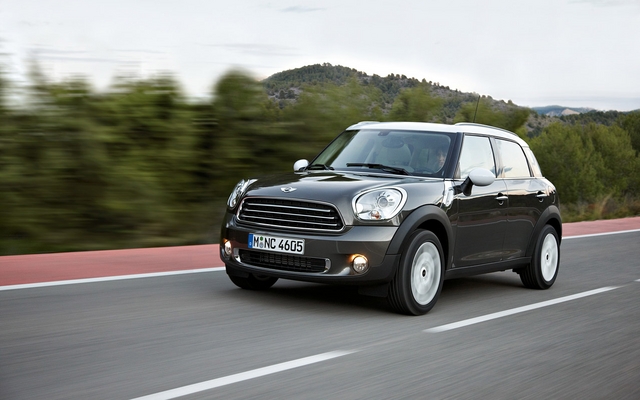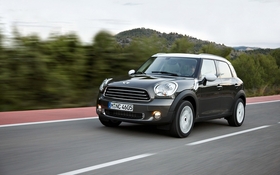The 2011 Mini Countryman: A Big Change for Mini

| Strong points |
|
|---|---|
| Weak points |
|
You know, English car fanatics are a bit of a different breed. Beyond their obsession with vehicles destined to break their wallets, and hearts (in that order), they’re one of those rare communities that seem free of internal strife and animosity. Get a group of Italians together, and the ensuing Ferrari vs. Lamborghini argument could come to blows. Similarly, getting a group of Frenchman together will undoubtedly result in much consternation surrounding Citroen’s various vehicles to a point at which each involved individual will inevitably retreat to their own corner. And the Germans? Well, we know how they settle their arguments, and let face it, most of their car companies were forged in the fires of war.
But that just doesn’t seem to be the case with the British. A Rolls Royce owner will just as readily stop for a Lotus Super 7 in distress as he would for a Bentley Boy in need, and vice versa. And yet, should you happen across a British car show, you might notice a sudden and incredibly abrupt divide located within the Mini camp. Upon one side, you’ll obviously find the old Minis; the ones designed and built as Sir Alec intended. And upon the other, you’ll find some BMW products. This is the newest of the latter.
And it certainly won’t be mistaken for anything else. Show this to a classic Mini enthusiast and the look on their face will probably be that of a constipated person sucking on a lemon. Sure, many of the same design traits are there, and yes the grille apes the old ones’ shape to a degree no other new Mini can match, but there’s one rather large, 3,252-pound hurdle: its size. With four proper doors and an available four-wheel drive system, it’s bloody gigantic. It may say Mini on the hood, but its dimensions are anything but.
However, there’s a pleasant flip side to its impressive proportions: a pleasantly spacious interior. If you’ve ever had the occasion to step inside a classic Mini, you’d know the amazing party trick that each and every Mini has managed to pull off until the brand’s recent re-launch: a seemingly larger interior than such a small exterior could contain. And although they may have been plenty comfortable, the new Mini Coopers just couldn’t match the space/time continuum-bending ability of the old ones. But this one comes pretty close. Thanks to the interesting rail system that replaces a conventional centre console, the seats can be positioned close together without feeling crowded, and the deeply scalloped interior door panels add even more elbow room. Also, with interchangeable pods that can be placed and slid along the rails, the entire system is wonderfully modular and can be adapted to whatever your needs may be. The seating position is quite similar to that of the standard Mini Cooper, albeit slightly taller, and is perhaps more comfortable as a result. One thing is certain, the additional height does dramatically improve the visibility from the driver’s seat; while you’re stuck stooping to view stoplights in a standard Mini, they’re out in the open when seen through the Countryman’s windshield.
And this is a good thing, because if you’re driving the standard, naturally aspirated Countryman that forms the base of the lineup, you’ll need to get a good jump off the line to keep up with traffic. Saddled with that not insubstantial amount of mass, the little 1.6 litre four cylinder struggles to motivate the big five door hatchback, and the combination of just 121 horsepower at 6,000 rpm and 114 foot-pounds at a surprisingly high 4,250 rpm conspire to keep you astride of that damn Grand Caravan that’s trying to cut you off. And although the inclusion of a six speed gearbox may sound like just the ticket to maximize the forward momentum, it seems like you spend about as much time shifting gears as you do sending power to the ground.
However, that Grand Caravan will fade from the rearview quite rapidly when the road turns twisty. Handling is, just as it always has been, still a Mini strong suit, and the Countryman does not stumble in this regard. In fact, the taller centre of gravity and slightly larger aspect-ratio tires, the handling might be even more fun than the much quicker Cooper S coupe. Still quick on its feet, the slightly less controlled body increases the effects of braking and accelerating through the corner, and makes the car a bit more prone to hooliganry and increases the chassis’ communication bandwidth to match. As a result, each tires’ adhesion level seems lower, but the driver’s sense of how much available traction remains feels heightened. It’s a great combination.
Tack all that on to a chassis that finally gives rear seat passengers their own rear doors and legroom to match, and you’ve easily got the most practical Mini BMW has produced. In fact, it’s probably the closest thing to the original that’s ever been produced… and coming from a British car fanatic, that’s high praise indeed.











